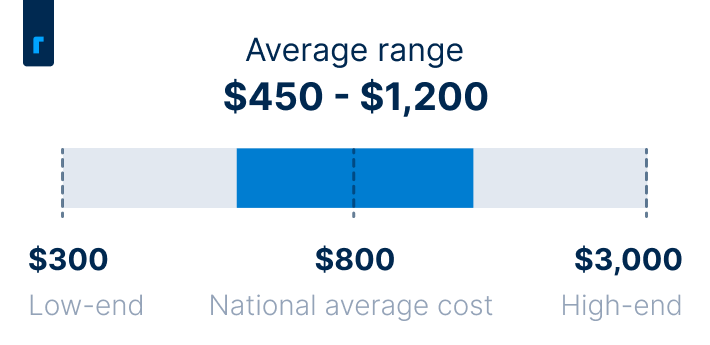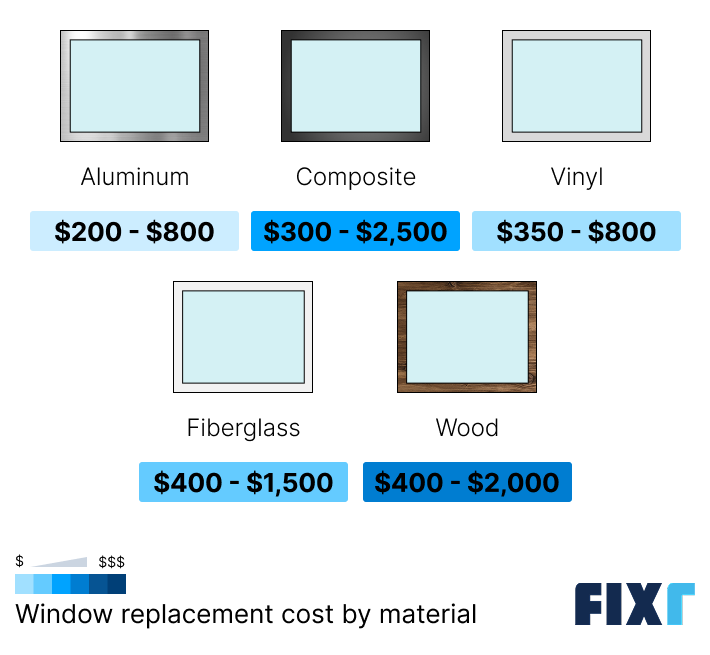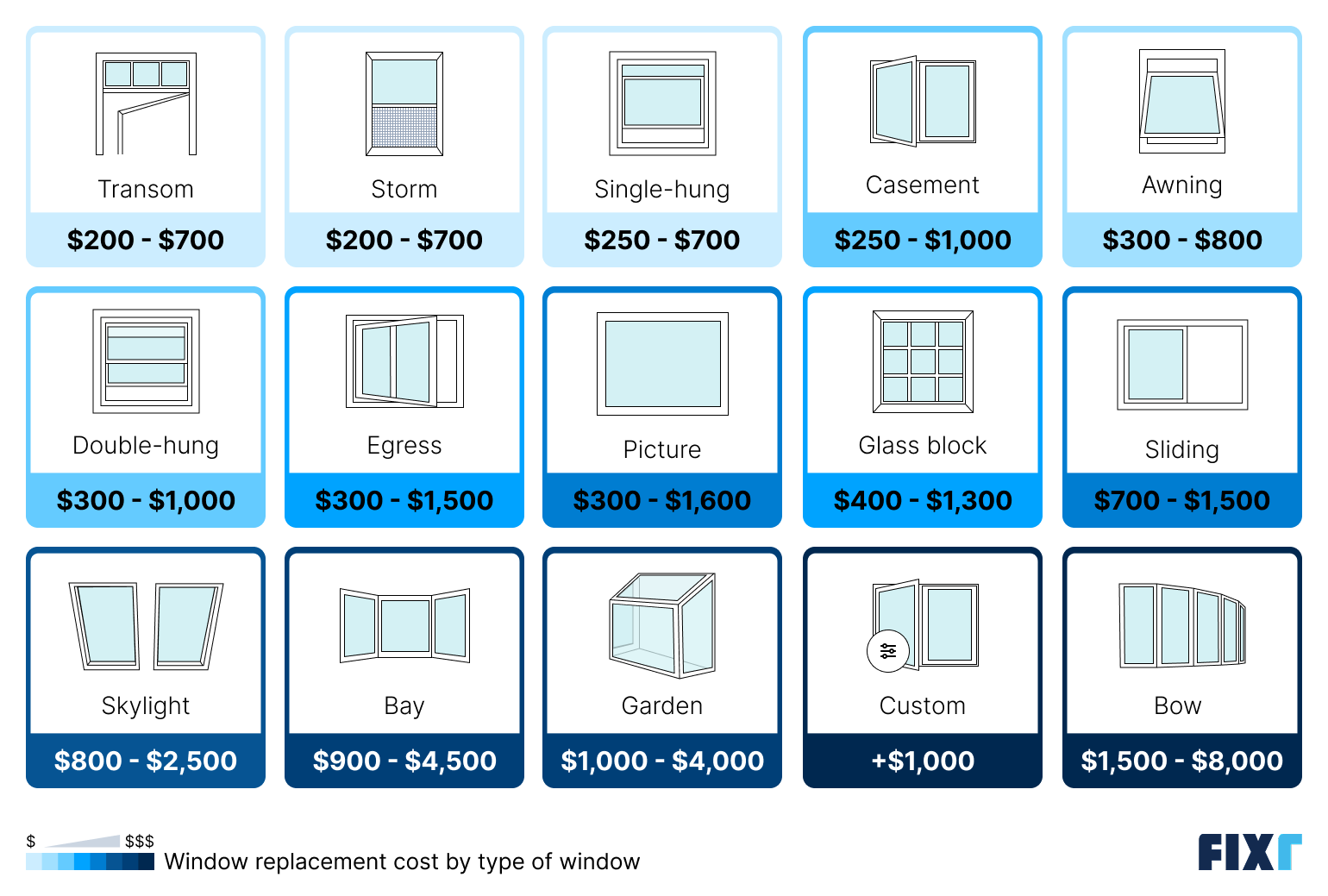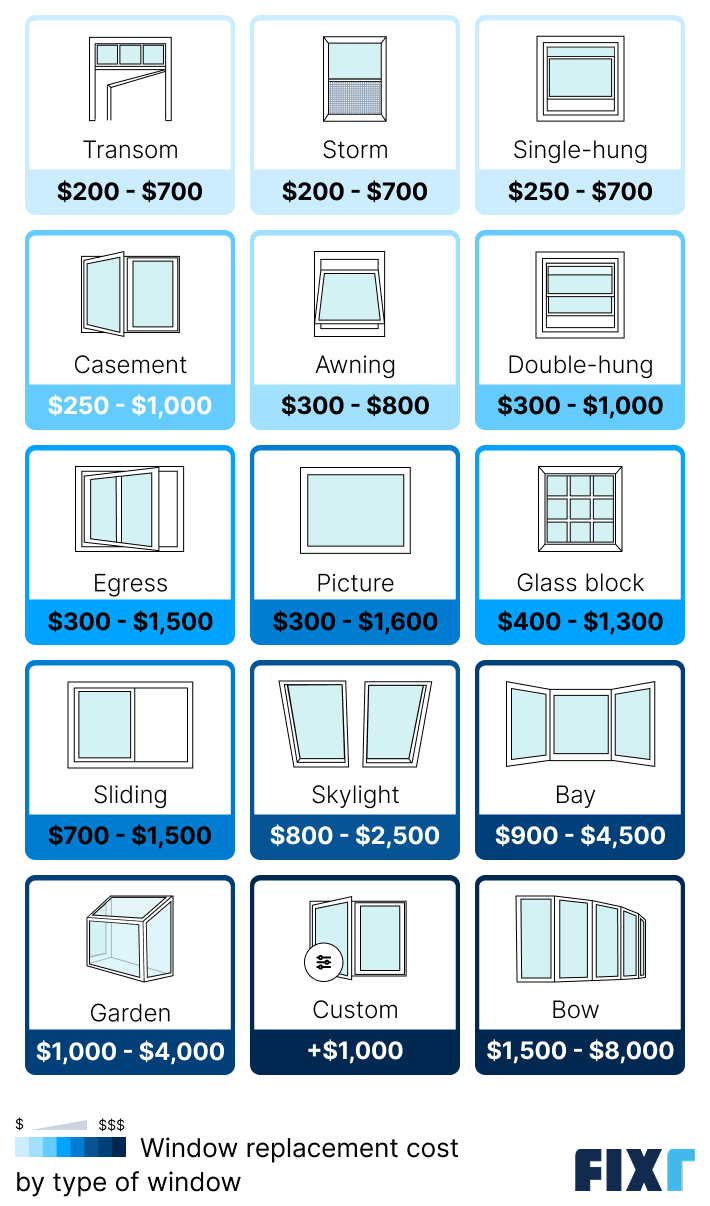Updated: August 22, 2025
Written by Dan Simms
Laura Madrigal is the Home Design Specialist at Fixr.com, dedicated to identifying and analyzing significant changes within residential design. She is the author of leading trends reports on interior design, kitchen, and bathroom, and her insights have been featured in publications like Realtor and the New York Post.
Learn moreReviewed by Laura Madrigal
Windows let sunlight into your living space, creating a warm and welcoming atmosphere, but more importantly, they keep the elements outside where they belong. Installing new windows can help keep your living space protected from harsh weather, improve your home’s energy efficiency, reduce heating and cooling costs, and even boost curb appeal, adding to your property value.
Window replacement costs an average of $800 per window, and the cost can range from $300 to $3,000 per window, depending on the window size, the type of window, and the frame and glass materials you choose.
Window Replacement Cost


Window Replacement Cost by Number of Windows
The average cost of replacing windows is $800 per window, and typical window replacement costs between $450 and $1,200 per window. Prices can vary widely depending on the type of window you choose. Basic vinyl models tend to cost less, while larger or custom options in wood or fiberglass fall on the higher end of the range.
Many window installers will offer a discount per window when you agree to replace multiple windows, so while your total will always increase as the number of windows does, your cost per window can come down a bit. These discounts vary widely, so check with your installer and manufacturer for volume discounts to see if bulk ordering will lead to savings.
Number of Windows | Average Cost Range |
1 | $450 - $1,200 |
5 - 10 | $2,250 - $12,000 |
11 - 20 | $4,950 - $24,000 |
21 - 25 | $9,450 - $30,000 |
Cost of Window Replacement by Frame Material
The frame material you decide on will affect your replacement window cost as well as the window’s appearance, longevity, durability, and energy efficiency. Vinyl is considered the standard window frame material, as it strikes a good balance between upfront cost, durability, and insulation.


Window Material | Cost per Window |
Aluminum | $200 - $800 |
Composite | $300 - $2,500 |
$350 - $800 | |
Fiberglass | $400 - $1,500 |
$400 - $2,000 |
A vinyl window will cost between $350 and $800, on average. Aluminum is the most budget-friendly material, but it offers less insulation than vinyl and can dent from impact. An aluminum window costs between $200 and $800, in most cases.
Fiberglass and composite window frames are the most energy-efficient and can help reduce heating and cooling costs, especially in more extreme climates. While they’re often among the least cost-effective materials, totaling between $300 and $2,500 per window for composite units and between $400 and $1,500 for fiberglass, on average, they can pay for themselves in utility bill savings and frame longevity over time. Wood frames are on the higher end of the price, but they have the longest lifespan and are the easiest to repair. Wood windows cost between $400 and $2,000 each.
Average Cost of Window Replacement by Window Type
When you’re deciding on the best window to install, key factors to consider include curb appeal, ventilation, ease of cleaning, operation, and security.
Your chosen window type and style directly influence material and labor costs. Simpler designs like picture windows or single-hung windows are less expensive for materials than windows with a more complex opening system, like casement windows or double-hung windows. Fixed windows like picture or garden windows offer maximum light and efficiency but lack ventilation and internal cleaning access. On the contrary, operable windows like casement or awning windows provide good ventilation and are easier to clean, but are less secure.
You can also purchase custom windows to meet your preferences, but custom building drives up material costs, so you’ll almost always pay more for non-standard sizes.


Window Type | Cost per Window |
Transom | $200 - $700 |
$200 - $700 | |
Single-hung | $250 - $700 |
$250 - $1,000 | |
Awning | $300 - $800 |
Double-hung | $300 - $1,000 |
$300 - $1,500 | |
$300 - $1,600 | |
$400 - $1,300 | |
$700 - $1,500 | |
Skylight | $800 - $2,500 |
$900 - $4,500 | |
$1,000 - $4,000 | |
Custom | $1,000+ |
Bow | $1,500 - $8,000 |
Egress windows can be much more expensive if you need to install the window well, but if you’re just replacing the window, the cost will be more in line with standard window replacement costs. Most egress windows are just regular windows installed in a well.
Average Window Replacement Cost by Glass and Pane Type
In addition to frame material and window style, you’ll have to choose the type and quality of glass you want, which can also make a big difference when it comes to cost and energy efficiency.
The most common options you’ll have to choose from will refer to the different number of glass layers. Single-pane window replacement costs the least, but these windows have just a single pane, making them the most affordable but the least insulative. Double-pane windows have two layers of glass with a layer of argon or krypton gas sealed between them for improved insulation. Triple-pane is the most expensive with three layers of glass and two layers of insulating gas.
You can also choose frosted glass for improved privacy for bathroom windows, laminated or tempered glass for improved security and a reduced risk of breaking during severe weather, or tinted or low-emissivity (low-E) glass for improved energy efficiency and lower energy bills, especially in hot, sunny climates.
Glass and Pane Type | Cost per window |
Single-pane | $200 - $650 |
Tempered | $250 - $800 |
Low-E | $300 - $1,100 |
Laminated | $300 - $1,200 |
Frosted | $350 - $800 |
Double-pane | $450 - $2,000 |
Triple-pane | $1,000 - $4,000 |
Some manufacturers offer tinted glass, but it’s more common to tint windows after installation. Tinting helps block sunlight that fades furniture and can reduce heat gain and cooling costs, especially in hot climates. Expect to pay between $10 and $100 per square foot.
Labor Cost to Remove and Replace Windows
The labor for window replacement costs between $150 and $300 for smaller windows and up to $800 for large bow or bay windows that require multiple installers to maneuver the window into place. On average, labor makes up 30% of your total.
Full House Window Replacement Cost vs. Individual
Replacing a single window will cost an average of $800. For an average single-story home that has 10 to 15 windows, you’re looking at a total between $8,000 and $12,000, while for the average two-story home that has 15 to 30 windows, your cost to replace all of the windows in your house will fall between $12,000 and $24,000.
Additional Cost Factors
The type of window, frame materials, glass materials, and the number of windows you replace will affect your overall costs the most, but there are some other minor cost factors you should consider.
Window Size & Customization
Larger windows will drive up your material costs because they need more glass and bigger frames to fill the space. Installing big windows usually takes more time and effort, so you might have to pay extra for labor, too. You’ll find that labor costs scale with window size.
Custom-sized windows also increase material costs. This is common in older homes with non-standard openings, as these windows cannot be mass-produced, leading to higher manufacturing expenses.
Structural Repairs & Framing
When your window replacement professional removes your old window, there’s a chance they’ll find hidden water damage or shifting framing that represents structural issues. You’ll need to make repairs before your new window can go in, which can cost a few hundred dollars or thousands, depending on the extent of the issue. This is hard to plan for, but if your windows are sticking or showing signs of active leaks, you should budget extra for hidden damage repair.
Glass Upgrades
Some homeowners budget for glass upgrades, like tempered or laminated glass for homes on golf courses or in areas prone to tornadoes and hurricanes. These upgrades can add between $100 and $800 per window to your project costs.
The same is true for energy efficiency upgrades, like low-E glass or tinted glass. These add to your total window replacement cost, too, but they can end up saving you money over time by reducing wear and tear on your HVAC system, reducing how quickly your flooring and furniture fade from UV exposure, and reducing energy bills.
Permit & Inspection Fees
Some municipalities require permits for window replacement in general, while most will require permits if you’re making structural changes, like changing the size of the wall opening. Permit fees depend on the fee schedule of your local building department, but they average between $50 and $300.
Disposal & Cleanup
Many professionals will include the cost of hauling away the existing windows and cleaning up the project site in your initial estimate, but others will charge separately. Haul-away fees can vary based on regulations and dumping fees in your area, so check with your installer before budgeting for this line item.
Accessibility
Finally, how accessible your window is can play a role in your installation costs. Windows on the second story will almost always cost more to replace than those on the first floor, as your installers will need to take on more risk and use additional equipment. This is especially true for large home windows on the second floor, which may require a crane to lift them into place.
Signs Your Windows Need Replacement
Not sure you even need to worry about window replacement costs? Here are a few signs it may be time to replace your windows:
You notice drafts: One of the most obvious signs of window damage is the presence of a draft in colder weather. It’s possible that a repair will do the trick, but a replacement may be best for maintaining energy efficiency.
Your heating/cooling bills are higher than usual: If those drafts aren’t so obvious, you may instead notice increasing heating and cooling bills. There are other reasons you could see an increase, but old windows plus energy bills could mean it’s time for a replacement.
There’s condensation between the panes: Condensation between the panes on double-pane and triple-pane windows means you have a broken seal. This often means the window has structural damage or is nearing the end of its life, so a replacement may be a good idea.
Your windows are difficult to open or close: Stuck sashes could result from swelling from humidity changes, but it could mean structural damage that requires a full replacement.
You see signs of a leak: If you notice water damage to the drywall around your window or rotting, soft, spongy frames, you have a leak that demands a window replacement.
In some cases, you can get by with a window repair, especially if there’s no evidence of drafts, structural damage, or a window leak.
DIY vs. Professional Installation
If you have the skills, it’s possible to DIY your window replacement project, and doing so will save you between $150 and $300 per window on labor costs.
The savings may be tempting, but it’s best to leave the job to a pro. First off, most window manufacturers will void your window’s warranty if you don’t have a professional perform the installation. That could mean higher repair costs down the road if something goes wrong with your window. A pro is also less likely to make mistakes that could lead to water or air leaks that result in expensive water damage or decreased energy efficiency and higher utility bills.
Finally, a professional can complete a window installation in just 1 to 4 hours, depending on the size of the window, while an inexperienced DIYer is likely to take a day or two. A faster installation will reduce how long your home’s interior is exposed to the elements.
Because the damage caused can be severe and include mold and other water issues, we generally don’t recommend this project as a DIY project

Niki O’Brien
Custom ExteriorsWhen hiring a window replacement professional, always get at least three estimates to make sure you’re paying a fair price. It’s safe to choose a contractor based on experience in the industry and customer reviews, but double-check the company’s Better Business Bureau rating to be safe.
How to Save on Window Replacement
Window replacement costs can get pricey, especially if you’re looking to replace multiple windows at once. There are a few things you can do to help keep costs down:
Replace multiple windows at once: Your total will be higher as you add more windows to your replacement project, but you could benefit from bulk discounts and discounted trip fees that help you save over time.
Schedule your project during the off-season: Window replacement companies are busiest in the spring and summer, so you may enjoy discounted labor in the fall or winter thanks to lower demand.
Take advantage of rebates and other incentives: You may qualify for rebates, tax credits, and other incentives from the federal government or your local municipality if you invest in ENERGY STAR-certified windows or high-efficiency upgrades.
Consider energy-efficient upgrades for long-term savings: Even if you won’t qualify for incentives, energy-efficient windows will help insulate your home, reducing heating and cooling costs and the strain on your HVAC system, which can save you on utility bills and HVAC maintenance over time.
Consider an insert window replacement: If the frame of your window is in good condition, you may be able to complete a pocket window or insert window replacement, which is when you replace just the sashes for a reduced fee.
FAQs
Replacement windows cost an average of $800 per window, and most individual windows have a price range of between $450 and $1,200, depending on size and frame and glass materials. It’s not uncommon for larger bay windows or bow windows to top $3,000.
Energy-efficient windows can provide an ROI of up to 85%, especially in extreme climates where they make a bigger difference. Not only will you see a high return, but you can also enjoy savings from reduced heating and cooling bills and less maintenance on your HVAC system before you sell, as well as potential rebates and tax credits from making energy efficiency upgrades to your home.
The expected cost of replacing windows depends on the climate in your area, your preference for frame material, and the durability and maintenance you’re looking for. Aluminum windows cost an average of $600 each but are really only suitable for more moderate climates, and they won’t last as long as many other materials. Fiberglass windows average $950 each, are much better suited to extreme climates, and have a much longer lifespan.
Your total cost will be higher as you add more windows to your replacement project, but you may save some money on a per-window basis. Manufacturers sometimes offer bulk discounts if you order multiple windows at once, and some installers will discount their labor per window if they know they have a larger job secured.
Yes, replacing windows will increase your home value because new windows boost your curb appeal and because buyers will have more confidence in the home they’re purchasing. Installing new windows provides a return on investment of between 60% and 85%, depending on the materials you choose.
Some contractors and window manufacturers offer financing for window replacement projects, but you can also take advantage of home renovation loans, home equity lines of credit (HELOCs), or personal loans to finance window replacement. It’s also possible to use credit cards, and some homeowners may be eligible for government-backed home improvement loans if they choose energy-efficient windows.
New windows will last anywhere from 10 to 60 years or more, with an average of 15 to 30 years. The lifespan depends mostly on the frame material. Aluminum windows last for 10 to 30 years, vinyl and fiberglass windows last for 20 to 50 years, composite windows last for 30 to 50 years, and wood windows last for 30 to 60 years.
